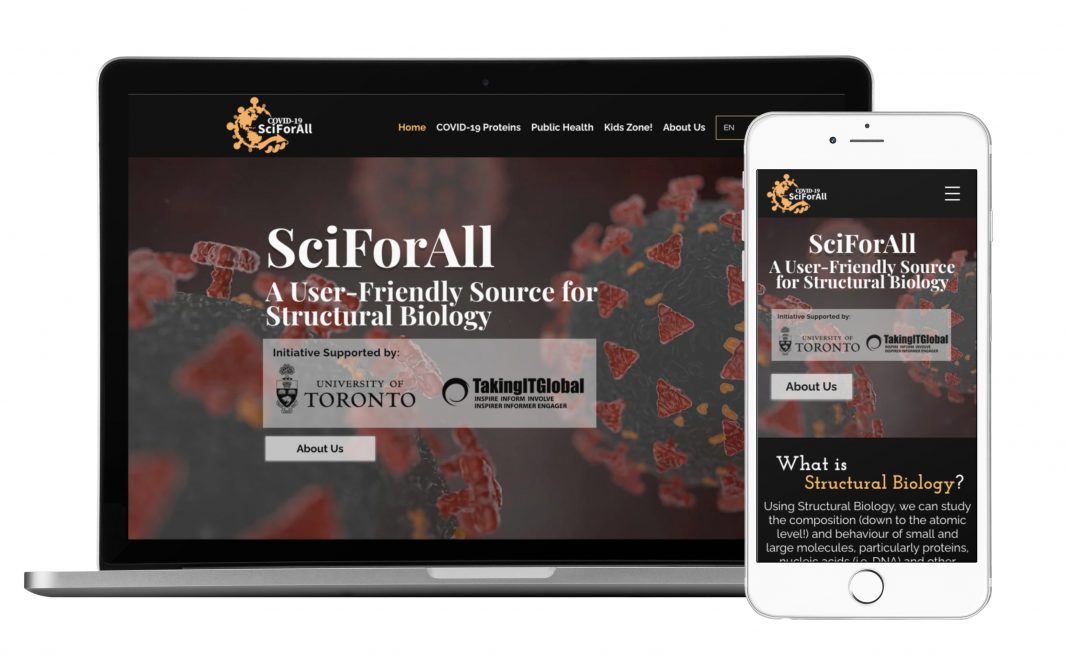The start of the Covid-19 pandemic brought forth an immense flow of research on the SARS-CoV-2 virus. However, at times, it was hard for the public to locate this reliable information. This inspired Amir Arellano Saab, a Ph.D. candidate of the McCourt Lab and Savchenko Lab at the University of Toronto, to present Covid-19 information to the public in a simple and effective manner. He wanted to provide information in conjunction with interactive graphics. To achieve his goal, he approached Katrina Hass, an MSc student at the University of Toronto’s Institute of Medical Science in Biomedical Communications. Amir’s passion for structural biology and Katrina’s experience as a medical science illustrator proved to be a meaningful collaboration in the form of SciForAll.org, a website where structural biology information is presented through interactive graphics.
SciForAll first went online in September 2020. To run the site and continuously update it, Arellano Saab and Hass are working alongside a team of students and scientists. “SciForAll took us three months [to assemble]—from conceiving the idea to releasing it,” recalls Arellano Saab. The initiative is supported by the University of Toronto and TakingITGlobal, a network that supports youth action and social innovation aimed at tackling global challenges.
Currently, the platform focuses on delivering information about Covid-19 through a structural biology perspective, hence providing accurate scientific data amid a time of misinformation about Covid-19. The site explores Covid-19’s main proteins, such as the Spike protein, the Main Protease, and the Envelope protein. Each page dedicated to the Covid-19 proteins is designed to be interactive: hovering the mouse over the figure allows the reader to discover more information. Hass states that the interactive features play a vital role in effectively delivering the information to the public. “The information [can be found] on other sites [which present information] in blocks of text; our website is different than that. It [includes] graphics and [makes them] interactive,” says Hass. The combination of short text excerpts and interactive graphics allows site visitors that do not have a scientific background to easily understand the ins-and-outs of the virus.
SciForAll also aims to develop children’s interest in structural biology. A section of the website called “Kid’s Zone” is dedicated to kids and explains Covid-19 in an even more interactive manner, providing fun resources for children to check. As such, the target audience of SciForAll is very broad, from adults to younger children.
The website also includes information on the misunderstood Covid-19 variants and a downloadable infographic, which is available on the website in multiple languages. SciForAll has fostered a very inclusive and accessible space by presenting information in four languages: English, French, Spanish, and Chinese, and the downloaded infographics are also available in Japanese. “This is a very important thing, not only to approach people on the other side of the world, but also to target underrepresented communities in Canada, [who] don’t have access to this type of information,” says Arellano Saab. “[We are] hopeful that by translating our content, we can reach those people.”
The process of designing content for the website begins with an idea. The main source of information for the website comes from primary literature and health organizations such as Public Health Canada and the World Health Organization. Next, the relevant information is assembled into a script by Arellano Saab, and Hass reviews it to determine if a reframing of the content is needed. The script is then used to design the layout of the webpage or the infographic. On the SciForAll website, it is essential that the content is displayed in sections that are easily palatable.
“A large challenge is making sure that text is good for the general public too,” says Hass when discussing the challenges in writing content for the website. Both Arellano Saab and Hass come from scientific backgrounds and found it initially challenging to tailor the scientifically loaded content into general terms for their target audience. “[We] need to find the right balance because you need the information to be scientifically accurate and at the same time easy to understand. That is sometimes where a lot of time is spent thinking,” says Arellano Saab.
In the near future, one of the main goals for the SciForAll team is public outreach and exposure on social media, which will hopefully increase traffic to the website. The team has recently published an infographic for the Covid-19 vaccines and hopes to translate the content on the website into more languages commonly spoken in the Greater Toronto Area to maximize its reach. In terms of long-term goals, the team hopes to expand the content offered on SciForAll to include topics such as the applications of structural biology beyond Covid-19.
The Covid-19 pandemic has led to a great increase in research and a flux of information on the new discoveries made. Initially, this information was largely available to the members of the scientific community who were able to easily access and understand it. SciForAll has successfully increased the accessibility and reliability of Covid-19-related information to the public through its innovative and interactive graphics. During such a sensitive and quickly evolving crisis, it is important to stop the spread of misinformation to not only protect ourselves from the virus, but also to protect each other.



